The world is making a shift towards digital and so are markets. Online markets are platforms where buyers and sellers can easily interact from all over the world (Dimoka, Hong & Pavlou, 2012). These markets have lower barriers than physical markets and allow customers to buy products or services at any time online while also having a much broader product selection. You can still go to the Nike Store to buy a pair of sneakers, but the chances are bigger for you to find them online.
Nonetheless, in 2022 it is still not easy to buy everything online and not return it. The biggest challenge for online markets is physical experience goods, which cannot be evaluated by customers before purchasing it. One reason for this is the difficulty in evaluating product, while another reason is evaluating the performance of the product (Urbany, Dickson & Wilkie, 1989). Customers are having hard times to distinguish between good and bad, because of some sellers’ inability and lack to provide buyers with proper product descriptions.
However, this problem has given others the opportunity to fill this gap in very creative ways. Individuals are creating businesses through YouTube channels by reviewing products, giving feedback and additional descriptions that customers are looking for, but are unable find the on the retailers’ websites or apps.
The biggest examples can be given from the fashion industry. Within this industry there are sellers, such as luxury brands like Bottega Veneta and Cartier that provide their customers with the right product description, such as how many card can fit in a card holder or images of how a certain necklace looks like on a model. The products are offered on several platforms such as the brand’s own website, but also on websites or apps such Farfetch and MyTheresa. Not all platforms provide customers with the right or necessary information package, while individuals on YouTube are making content videos to show how a certain card holder looks like, how many cards it can actually hold, what the perceived quality is, and in which bags (small, medium, large) it will fit.
It is interesting to see how the concept of online markets can have its benefits and limitations. On the one hand, concepts as product uncertainty and seller uncertainty arise, while on the other hand new concepts, content and jobs are created from these uncertainties. The future will tell if YouTube review channels are there to stay or will they be outperformed by new technologies that diminish these uncertainties?
References:
Dimoka, A., Hong, Y., & Pavlou, P. (2012). On Product Uncertainty in Online Markets: Theory and Evidence. MIS Quarterly, 36(2), 395.
Urbany, J., Dickson, P., & Wilkie, W. (1989). Buyer Uncertainty and Information Search. Journal Of Consumer Research, 16(2), 208.


